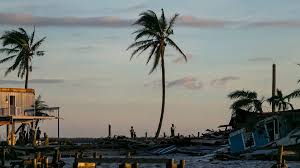Top Stories
Hurricane Milton tracker: Storm strengthens into dangerous Category 3, path headed for Florida later this week

Hurricane Milton, which formed in the Gulf of Mexico on Saturday afternoon as a tropical storm, has quickly strengthened into a dangerous Category 3 hurricane this morning, with maximum sustained winds of nearly 125 mph.
In its latest advisory, the National Hurricane Center warns that Milton is expected to continue building “to become an extremely dangerous Category 4 hurricane later today and maintain that intensity for the next couple of days.” Winds could strengthen to 155 mph as the storm continues to gain power in the coming days, the hurricane center said.
The Associated Press reports that about 7 million people are now being urged to evacuate Florida, which is still recovering from the devastation left by Hurricane Helene last week. Per the AP, Milton’s projected path suggests it could make landfall in the Tampa Bay area on Wednesday evening and remain a hurricane as it continues moving northeastward across the state.
In a statement issued Sunday, the White House said that President Biden had been briefed on the situation — including the hurricane’s “potential impacts” on the Florida Gulf Coast and the work the Federal Emergency Management Agency (FEMA) is doing in advance of the storm.
The Mexican government issued a hurricane watch for the coast of Mexico from Celestún to Cabo Catoche, and a tropical storm warning from Celestún to Cancun, according to the NHC. Those in the Florida Peninsula, the Florida Keys and the northwestern Bahamas are also being urged to monitor its progress.
Where is Hurricane Milton and what is its path?
As of Monday, 8 a.m. ET:
- Milton was located around 165 miles west-northwest of Progreso, Mexico.
- It was about 745 miles west-southwest of Tampa, Fla.
- The storm had maximum sustained winds of 125 mph.
- The storm was moving east-southeast at 8 mph.
The NHC warned Monday morning of “an increasing risk of life-threatening storm surge and damaging winds for portions of the west coast of the Florida Peninsula beginning Tuesday night or early Wednesday.”
“Residents in that area should follow any advice given by local officials and evacuate if told to do so,” the NHC said.
Portions of the Florida Peninsula and the Florida Keys can expect rainfall of 5 to 10 inches, with localized totals up to 15 inches through Wednesday night. Such rainfall brings “the risk of considerable flash, urban and areal flooding, along with the potential for moderate to major river flooding,” meteorologists said.
Meanwhile, portions of the northern Yucatan Peninsula can expect 2 to 4 inches of rainfall.
Meanwhile, Hurricane Kirk has diminished to a Category 1 hurricane. As of Monday morning, Kirk was approximately 765 miles from the Azores, moving north-northeastward at 23 mph, with maximum sustained winds of 75 mph. There are no coastal watches or warnings in effect, according to the NHC.
Milton comes days after Helene
Hurricane Milton comes just over a week after Hurricane Helene made landfall in Florida’s Big Bend region as a monstrous Category 4 storm, causing at least 20 deaths in Florida alone.
After making landfall with 140 mph winds, the storm moved inland across the Southeast, leaving more than 200 people dead and leaving widespread destruction in its wake. Following the storm, the state’s infrastructure and emergency services have been stretched thin. As of 5:10 p.m. ET on Sunday, over 350,000 utility customers were still without power in Florida.
Read more from Yahoo News: Helene shows that hurricanes in the age of climate change don’t wreck just coastlines
Active hurricane season
Hurricane season runs from June 1 through Nov. 30, but the peak of heightened activity is usually from August through October. According to the National Oceanic and Atmospheric Administration, a “typical” hurricane season in the Atlantic will usually see around 14 named storms, “of which seven become hurricanes and three become major hurricanes.”
As of early October, eight hurricanes formed in the Atlantic — with Milton becoming the 13th named storm of the Atlantic hurricane season. As CNN notes, hurricane season is running ahead of the expected schedule. Typically, the 13th storm of the season wouldn’t hit until at least Oct. 25.
Earlier this week, Homeland Security Secretary Alejandro Mayorkas warned that FEMA did not have the funds to make it through the season. President Biden said this week that Congress may need to pass a supplemental spending bill in the next couple of months to help fund states’ recovery efforts.


 News19 hours ago
News19 hours agoBankit Revolutionizes Financial Services with Cutting-Edge Mobile Banking App

 Top Stories19 hours ago
Top Stories19 hours agoBREAKING: Tragedy at Ooni’s former wife, ‘Queen Naomi’s event as stampede kills one,many injured’

 Sports19 hours ago
Sports19 hours agoWhy Lookman won CAF Men’s Player of the Year – Dad

 Sports24 hours ago
Sports24 hours agoFIFA Best Awards 2024: Vinicius Jr Named The World’s Best Men’s Player

 Top Stories5 hours ago
Top Stories5 hours agoTax Reform: AGF Fagbemi To Meet Senate Today

 Entertainment31 minutes ago
Entertainment31 minutes agoIbadan Tragedy: Ooni’s Ex Wife, Others Face Probe As 32 Kids Feared Dead

 Sports5 hours ago
Sports5 hours agoSerie A: Lookman credits Atalanta for rise to stardom

 Business and Brands5 hours ago
Business and Brands5 hours agoHackers gain control of NBS website








